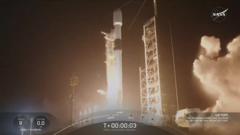The missions mark a significant advancement in private space exploration and commercial endeavors on the lunar surface.
SpaceX Successfully Launches Private Lunar Missions Aboard Falcon 9 Rocket

SpaceX Successfully Launches Private Lunar Missions Aboard Falcon 9 Rocket
Two commercial lunar landers from America and Japan begin their journey to the Moon.
On Wednesday, a SpaceX Falcon 9 rocket successfully launched two lunar landers as part of a rideshare mission to the Moon. The takeoff occurred at 01:09 local time (06:09 GMT) from the Kennedy Space Center in Florida, carrying the landers from America's Firefly Aerospace and Japan's ispace. Each lander is set to conduct independent explorations once they reach the Moon's orbit.
The Blue Ghost rover from Firefly is projected to take approximately 45 days to reach lunar orbit after separating from the rocket. Its mission encompasses drilling into the lunar soil, collecting samples, and capturing X-ray images of Earth's magnetic field, with the goal of enhancing research for future human missions on the Moon and understanding how space weather affects Earth, as outlined by SpaceX.
In contrast, ispace's Resilience lander is expected to take up to five months before touching down on the Moon's surface. After landing, it will deploy a rover tasked with exploration and the collection of loose lunar surface material known as regolith. This collaborative venture has garnered backing from NASA and, if successful, will represent the largest commercial delivery to the Moon to date.
This historic event follows Intuitive Machines' successful lunar landing last year, marking the first commercial organization to accomplish such a feat, previously conducted only by a handful of national space agencies including the US, Soviet Union, China, India, and Japan.
In another significant pursuit, SpaceX is set to conduct its seventh orbital flight test of the Starship rocket later this day, which is scheduled to launch from Texas at 16:00 local time (22:00 GMT). The ongoing advancements in private space missions exemplify the growing collaboration between commercial entities and national space organizations in exploring the final frontier.
The Blue Ghost rover from Firefly is projected to take approximately 45 days to reach lunar orbit after separating from the rocket. Its mission encompasses drilling into the lunar soil, collecting samples, and capturing X-ray images of Earth's magnetic field, with the goal of enhancing research for future human missions on the Moon and understanding how space weather affects Earth, as outlined by SpaceX.
In contrast, ispace's Resilience lander is expected to take up to five months before touching down on the Moon's surface. After landing, it will deploy a rover tasked with exploration and the collection of loose lunar surface material known as regolith. This collaborative venture has garnered backing from NASA and, if successful, will represent the largest commercial delivery to the Moon to date.
This historic event follows Intuitive Machines' successful lunar landing last year, marking the first commercial organization to accomplish such a feat, previously conducted only by a handful of national space agencies including the US, Soviet Union, China, India, and Japan.
In another significant pursuit, SpaceX is set to conduct its seventh orbital flight test of the Starship rocket later this day, which is scheduled to launch from Texas at 16:00 local time (22:00 GMT). The ongoing advancements in private space missions exemplify the growing collaboration between commercial entities and national space organizations in exploring the final frontier.




















